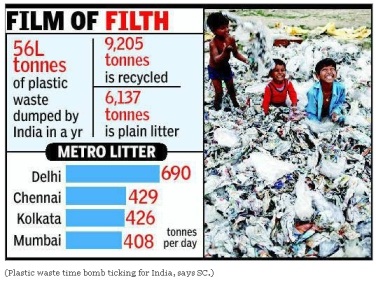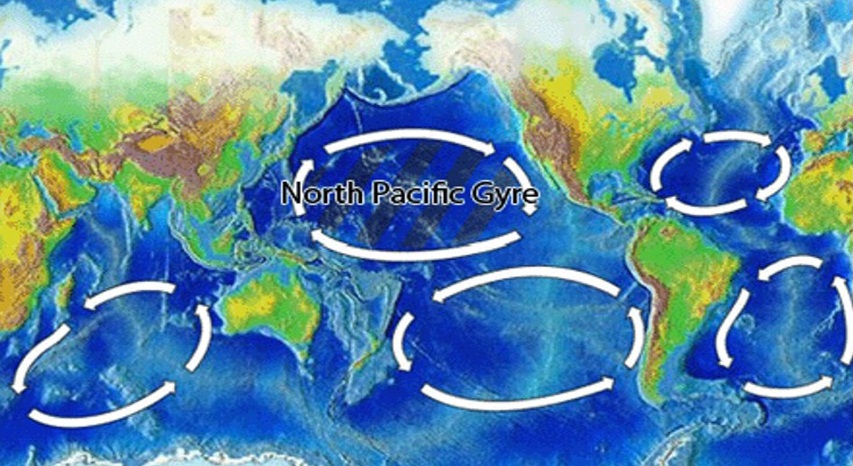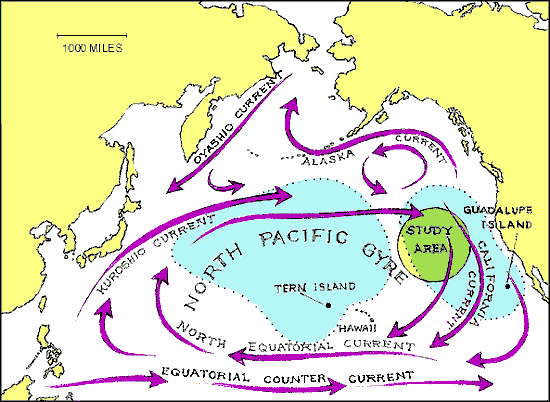Plastic Story in India
 “We are sitting on a plastic time bomb,” the Supreme Court said on Wednesday after the Central Pollution Control Board (CPCB) informed it that India generates 56 lakhtonnes of plastic waste annually, with Delhi accounting for a staggering 689.5 tonnes a day.
“We are sitting on a plastic time bomb,” the Supreme Court said on Wednesday after the Central Pollution Control Board (CPCB) informed it that India generates 56 lakhtonnes of plastic waste annually, with Delhi accounting for a staggering 689.5 tonnes a day.
“Total plastic waste which is collected and recycled in the country is estimated to be 9,205 tonnes per day (approximately 60% of total plastic waste) and 6,137 tonnes remain uncollected and littered,” the CPCB said.
The four metros are major culprits in generating such waste, with Delhi producing 689.5 tonnes a day, followed by Chennai (429.4 tonnes), Kolkata (425.7 tonnes) and Mumbai (408.3 tonnes). The figures only serve to confirm the common sight of mounds of plastic in industrial, residential and slum areas of Indian cities and towns.
As 40% of plastic waste is not recycled, the daily addition to untreated plastic in Delhi is estimated at 275.6 tonnes, followed by Chennai (171.6 tonnes), Kolkata (170 tonnes) and Mumbai (163.2 tonnes). This waste is a source of continuing pollution as plastic is not bio-degradable and poisons the environment for decades.
The CPCB said a survey conducted in 60 major cities found that 15,342.46 tonnes of plastic waste was generated every day, amounting to 56 lakh tonnes a year.

Plastic Story in USA
In 1974 the first single use plastic bags were introduced to stores and presently over One Trillion bags are used each year.
If you placed one year’s worth of plastic bags end to end, they would go around the Earth almost 36,000 times.
If you placed one year’s single use plastic bags end to end, they would go to the moon and have enough bags left to circle the moon several times each year.
There are 14,000,000 trees cut each year to make paper bags for consumers.
Single use plastic bags cost the store ¼ of one cent (.0025) but it cost the store five cents to recycle them (.05). What do you think the majority of stores are doing even if they are collecting the bags?
A family of four uses approximately 1,500 single use plastic bags each year.
There is an ever-growing patch of discarded plastic in the Pacific Ocean the size of Texas and ships must navigate around it.
Fish in the Ocean confuse plastic pieces for plankton and scientists have found that they eat more plastic than plankton. Wildlife is also dying from becoming entangled in plastic.
In the US alone, it takes 12 million barrels of oil to produce one year’s worth of single-use plastic bags.
“Does charging a fee on single-use bags really work?” The answer lies in our Nation’s Capital. In January of 2010, a .05 fee was placed on single-use plastic bags and in six month’s time, use of those bags has decreased by 65%. Consumers in Washington say it is not the .05 fee but the “guilt” associated with using plastic bags at the check out counter.
Plastic Story in Oceans :
One of the most serious threats to our oceans is plastics pollution. Plastic constitutes approximately 90% of all trash floating on the ocean’s surface, with 46,000 pieces of plastic per square mile. Why is there so much plastic in the ocean? Unlike other types of trash, plastic does not biodegrade; instead, it photo-degrades with sunlight, breaking down into smaller and smaller pieces, but they never really disappear. These plastic pieces are eaten by marine life, wash up on beaches, or break down into microscopic plastic dust, attracting more debris.
Plastic poses a significant threat to the health of sea creatures, both big and small. Over 100,000 marine mammals and one million seabirds die each year from ingesting or becoming entangled in plastic.
It takes 500-1000 years for plastic to degrade. Even if we stopped using plastics today, they will remain with us for many generations, threatening both human and ocean health. Despite these alarming facts, there are actions we can take to address the problem of plastics.
The United Nations Environment Programme estimated in 2006 that every square mile of ocean contains 46,000 pieces of floating plastic.Once discarded, plastics are weathered and eroded into very small fragments known as micro-plastics.
These together with plastic pellets are already found in most beaches around the world.Plastic debris causes the deaths of more than a million seabirds every year, as well as more than 100,000 marine mammals.
Plastic materials and other litter can become concentrated in certain areas called gyres as a result of marine pollution gathered by oceanic currents. There are now 5 gyres in our ocean.

The North Pacific Gyre, known as the Great Pacific Garbage Patch, occupies a relatively stationary area that is twice the size of Texas. Waste material from across the North Pacific Ocean, including coastal waters off North America and Japan, are drawn together.

Courtesy & Source : UNESCO, Takepart, Times of India, Google
Up Next more facts on PLASTIC STORY SERIES-2 : Australia, UK and Canada
Comment your country’s name, we would bring more statistics for you…
Related articles
- Choking on plastic in Chennai (thehindu.com)
- More plastic bags mean bad news for world’s turtles (greenfudge.org)
- The Plastic Bank: Monetizing Waste Plastic (peakoil.com)
- Crying foul (thehindu.com)
- Plastic Bag Ban Report Call for Papers (discardstudies.wordpress.com)
- Black plastic bags, dangerous but popular (liveinindonesia.com)
- Corporation to intensify drive against plastics (thehindu.com)
- State Senator Proposes Taxing Plastic Bags (pittsburgh.cbslocal.com)

